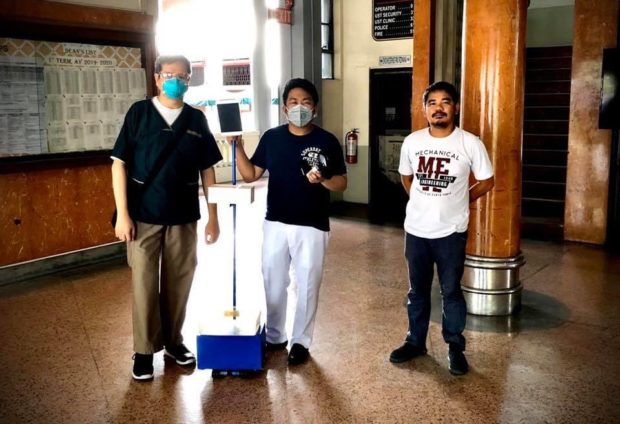
WARD ASSISTANT “Lisa’’ developer Anthony James Bautista (right) turns over his robotic creation to Dr. Marcellus Francis Ramirez and Dr. Michael Edward Lay of the University of Santo Tomas Hospital. —PHOTO COURTESY OF UST DEPARTMENT OF MEDICAL EDUCATION AND RESEARCH
Need to keep your distance? Let Lisa help you out.
At the University of Santo Tomas (UST) Hospital, a remote-controlled robot helps frontliners tend to patients stricken by the coronavirus disease.
The Logistic Indoor Service Assistant or Lisa robot has been deployed at the Manila hospital to assist frontliners in the fight against COVID-19. The manually operated robot has a mobile base, a body, a small compartment box for medicine and other small items, and a tablet that allows health workers to communicate with patients.
Medical personnel can control the unit from 5 to 10 meters away, thereby lessening physical contact with patients, according to Lisa developer and faculty researcher Anthony James Bautista.
“From that distance, health workers can communicate with their patients via video call. Not only can this minimize the contact, this will also conserve valuable personal protective equipment,” he told the Inquirer.
Telepresence
Bautista conceptualized the Lisa robot together with his friend, Dr. Rodrigo Calalang Santos of Pasig Doctors Medical Center. Calalang asked Bautista if there was a possibility of developing a telepresence robot for the hospital.
Within four days of working at the UST Faculty of Engineering laboratory, Bautista and technician Jun Cave came up with Lisa, a Level 1 automation robot. They made use of tools and components they could find in the laboratory.
“One of our biggest challenges right now is the limited access to components,” said Bautista, who used a number of tools for a project with the Department of Science and Technology.
He learned abroad the technology he used in developing the Lisa robot, said Bautista, who is currently doing research on an autonomous hand tractor project for rice farmers.
Cost: P12K
The finished product cost P12,000, excluding the tablet mounted on the robot.
“We made sure that the robot was cheap, practical. We also made sure this could be easily developed in case other hospitals want to produce their own [telepresence] robot,” Bautista said.
The first Lisa robot was deployed last week at UST Hospital. Last month, the hospital’s frontline personnel were stretched to the limit after 530 of its medical staff went on isolation after exposure to a COVID-19 patient.
Bautista said the next units of the Lisa robot would be improved based on feedback from the hospital. For one, the base will have to be altered to hold four wheels so the robot does not slip on the floor, he said.
The work team will also use Android apps to guide the robot instead of a remote control as this unit is hard to procure at the moment.
Passionate
The Lisa robot will also be covered to prevent contamination.
Three hospitals—Pasig Doctors Medical Center, Marikina Valley Medical Center and Binangonan Lakeview Hospital—are set to receive their own Lisa robots.
“I’m very passionate to contribute possible solutions for our health workers. My contribution pales in comparison with their sacrifices to save patients,” Bautista said.